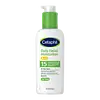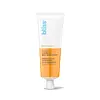What's inside
What's inside
 Key Ingredients
Key Ingredients

 Benefits
Benefits

 Concerns
Concerns

 Ingredients Side-by-side
Ingredients Side-by-side

Butyl Methoxydibenzoylmethane 3%
UV AbsorberOctocrylene 10%
UV AbsorberWater
Skin ConditioningDiisopropyl Adipate
EmollientCyclomethicone
EmollientGlycerin
HumectantGlyceryl Stearate
EmollientPEG-100 Stearate
Polymethyl Methacrylate
Phenoxyethanol
PreservativeBenzyl Alcohol
PerfumingAcrylates/C10-30 Alkyl Acrylate Crosspolymer
Emulsion StabilisingTocopheryl Acetate
AntioxidantCarbomer
Emulsion StabilisingDisodium EDTA
Triethanolamine
BufferingButyl Methoxydibenzoylmethane 3%, Octocrylene 10%, Water, Diisopropyl Adipate, Cyclomethicone, Glycerin, Glyceryl Stearate, PEG-100 Stearate, Polymethyl Methacrylate, Phenoxyethanol, Benzyl Alcohol, Acrylates/C10-30 Alkyl Acrylate Crosspolymer, Tocopheryl Acetate, Carbomer, Disodium EDTA, Triethanolamine
Water
Skin ConditioningCaprylic/Capric Triglyceride
MaskingGlycerin
HumectantButyrospermum Parkii Butter
Skin ConditioningPolysilicone-11
C15-19 Alkane
SolventSqualane
EmollientCetearyl Alcohol
EmollientHelianthus Annuus Seed Oil
EmollientSaccharide Isomerate
HumectantPEG-100 Stearate
Glyceryl Stearate
EmollientPropanediol
SolventTetrahexyldecyl Ascorbate
AntioxidantTocopherol
AntioxidantPanthenol
Skin ConditioningPyrus Communis Fruit Extract
Skin ConditioningCucumis Sativus Fruit Extract
EmollientLavandula Angustifolia Flower/Leaf/Stem Extract
MaskingRosmarinus Officinalis Leaf Extract
AntimicrobialCamellia Sinensis Leaf Extract
AntimicrobialCetearyl Olivate
Caprylyl Methicone
Skin ConditioningPolyglyceryl-4 Laurate/Succinate
Hydroxyethyl Acrylate/Sodium Acryloyldimethyl Taurate Copolymer
Emulsion StabilisingSorbitan Olivate
EmulsifyingSorbitan Isostearate
EmulsifyingPolysorbate 60
EmulsifyingCetearyl Glucoside
EmulsifyingLaureth-12
EmulsifyingTin Oxide
AbrasiveMica
Cosmetic ColorantSynthetic Fluorphlogopite
Triethoxycaprylylsilane
Sodium Citrate
BufferingSodium Phytate
Phenoxyethanol
PreservativeEthylhexylglycerin
Skin ConditioningCitric Acid
BufferingCI 77891
Cosmetic ColorantWater, Caprylic/Capric Triglyceride, Glycerin, Butyrospermum Parkii Butter, Polysilicone-11, C15-19 Alkane, Squalane, Cetearyl Alcohol, Helianthus Annuus Seed Oil, Saccharide Isomerate, PEG-100 Stearate, Glyceryl Stearate, Propanediol, Tetrahexyldecyl Ascorbate, Tocopherol, Panthenol, Pyrus Communis Fruit Extract, Cucumis Sativus Fruit Extract, Lavandula Angustifolia Flower/Leaf/Stem Extract, Rosmarinus Officinalis Leaf Extract, Camellia Sinensis Leaf Extract, Cetearyl Olivate, Caprylyl Methicone, Polyglyceryl-4 Laurate/Succinate, Hydroxyethyl Acrylate/Sodium Acryloyldimethyl Taurate Copolymer, Sorbitan Olivate, Sorbitan Isostearate, Polysorbate 60, Cetearyl Glucoside, Laureth-12, Tin Oxide, Mica, Synthetic Fluorphlogopite, Triethoxycaprylylsilane, Sodium Citrate, Sodium Phytate, Phenoxyethanol, Ethylhexylglycerin, Citric Acid, CI 77891
Ingredients Explained
These ingredients are found in both products.
Ingredients higher up in an ingredient list are typically present in a larger amount.
Glycerin is already naturally found in your skin. It helps moisturize and protect your skin.
A study from 2016 found glycerin to be more effective as a humectant than AHAs and hyaluronic acid.
As a humectant, it helps the skin stay hydrated by pulling moisture to your skin. The low molecular weight of glycerin allows it to pull moisture into the deeper layers of your skin.
Hydrated skin improves your skin barrier; Your skin barrier helps protect against irritants and bacteria.
Glycerin has also been found to have antimicrobial and antiviral properties. Due to these properties, glycerin is often used in wound and burn treatments.
In cosmetics, glycerin is usually derived from plants such as soybean or palm. However, it can also be sourced from animals, such as tallow or animal fat.
This ingredient is organic, colorless, odorless, and non-toxic.
Glycerin is the name for this ingredient in American English. British English uses Glycerol/Glycerine.
Learn more about GlycerinGlyceryl Stearate is a mix of glycerin and stearic acid.
It is used to stabilize the mixing of water and oil ingredients. By preventing these ingredients from separating, it can help elongate shelf life. It can also help thicken the product's texture.
As an emollient, it helps soften skin and supports barrier-replenishing ingredients.
In cosmetics, Glyceryl Stearate is often made from vegetable oils or synthetically produced.
This ingredient may not be fungal-acne safe
Fun fact: The human body also creates Glyceryl Stearate naturally.
Learn more about Glyceryl StearatePeg-100 Stearate is an emollient and emulsifier. As an emollient, it helps keep skin soft by trapping moisture in. On the other hand, emulsifiers help prevent oil and water from separating in a product.
PEGS are a hydrophilic polyether compound . There are 100 ethylene oxide monomers in Peg-100 Stearate. Peg-100 Stearate is polyethylene glycol ester of stearic acid.
Phenoxyethanol is a preservative that has germicide, antimicrobial, and aromatic properties. Studies show that phenoxyethanol can prevent microbial growth. By itself, it has a scent that is similar to that of a rose.
It's often used in formulations along with Caprylyl Glycol to preserve the shelf life of products.
Water. It's the most common cosmetic ingredient of all. You'll usually see it at the top of ingredient lists, meaning that it makes up the largest part of the product.
So why is it so popular? Water most often acts as a solvent - this means that it helps dissolve other ingredients into the formulation.
You'll also recognize water as that liquid we all need to stay alive. If you see this, drink a glass of water. Stay hydrated!
Learn more about Water